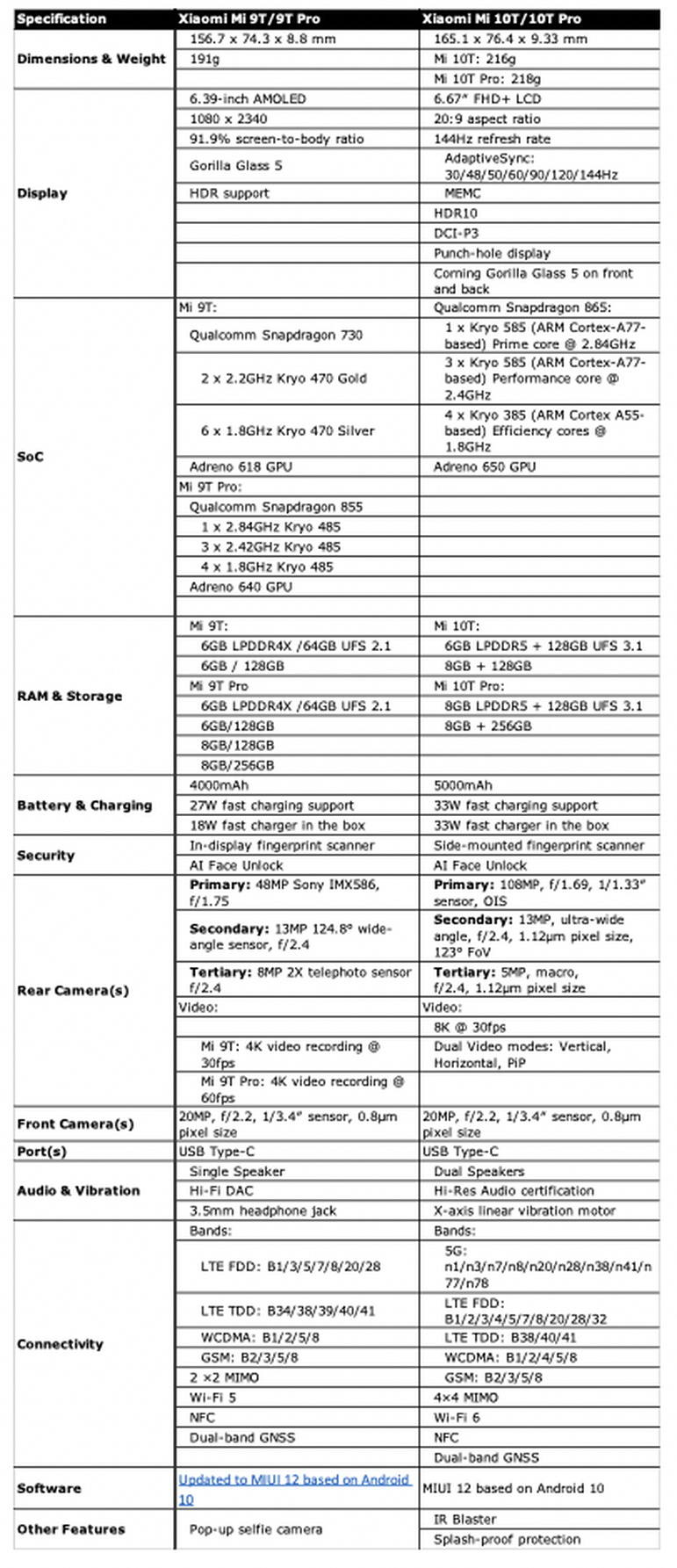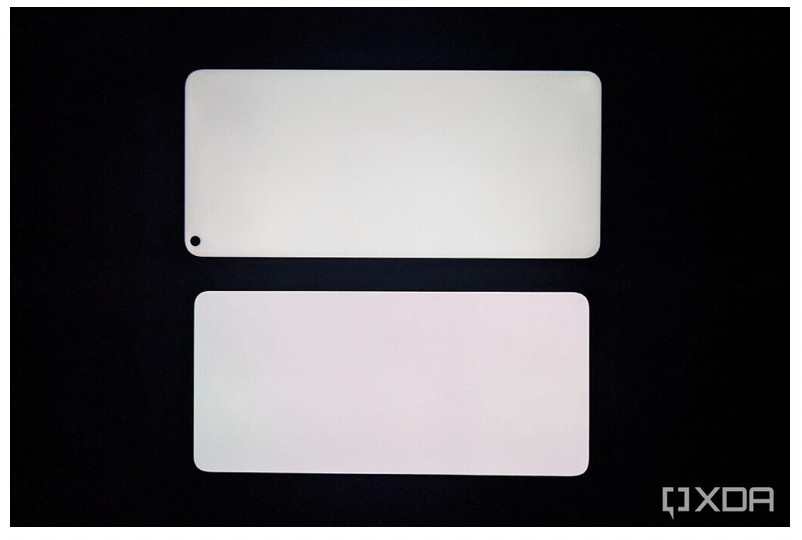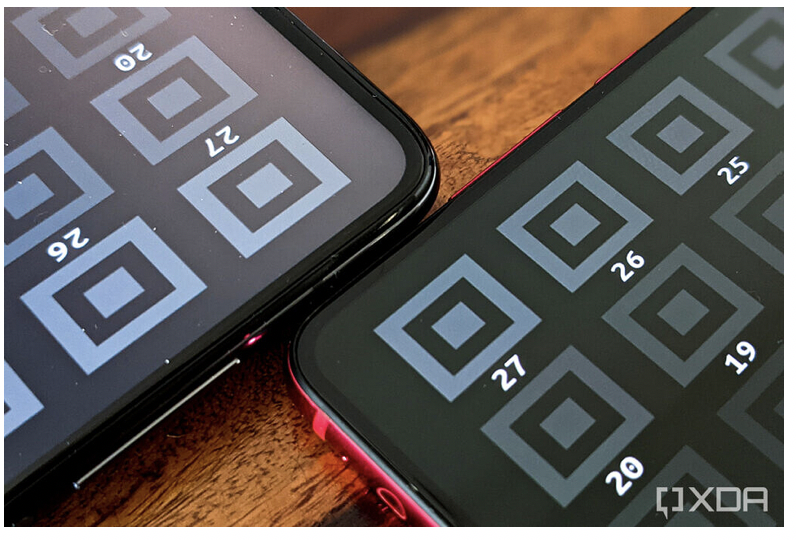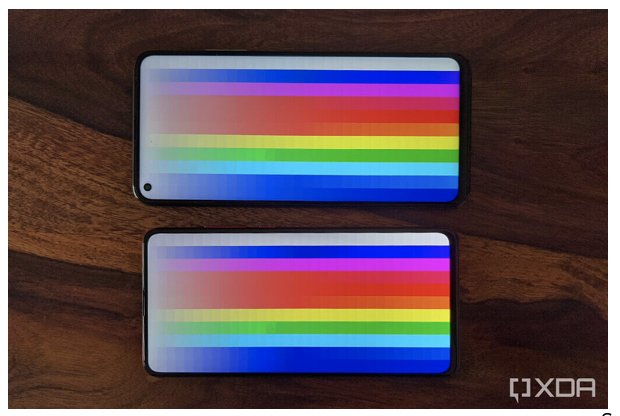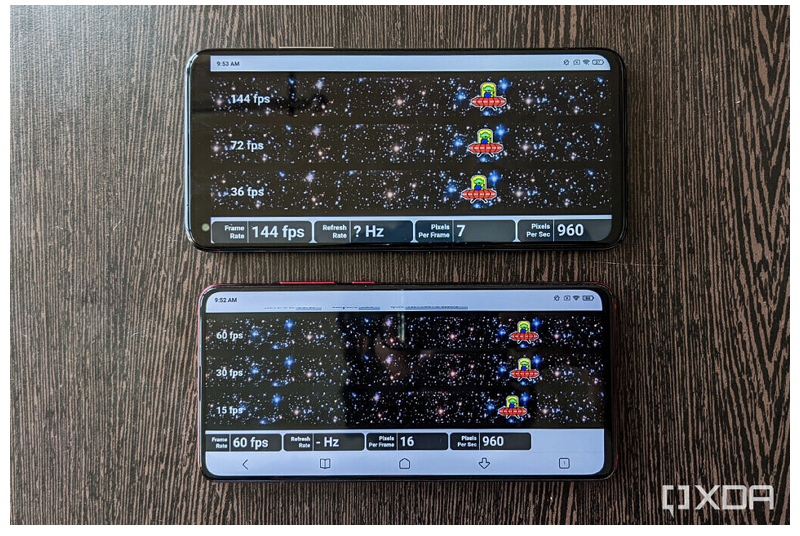Vertical Divider
Xiaomi Compares the Performance of OLEDs vs. LCDs
Recently, we reported on a Xiaomi’s executives feeble justification for relying on LCDs rather than a wholesale switch to OLEDs. Last week, Xdadevelopers, performed a head to head display comparison of the company’s LCD flagship series (Mi10T) and the OLED flagship series (Mi 9T), which we essentially reproduce below. They point to some performance improvements of the LCD over the OLED namely, the effect of higher refresh rates and better color uniformity. We must point out that the OLED shortcomings are likely an indictment of the Chinese OLED vendor used by Xiaomi (probably BOE), since Samsung’s OLED displays have been judged by DisplayMate to have almost perfect color rendition and uniformity.
The Xiaomi Mi 10T and the Mi 10T Pro are Xiaomi’s latest flagship-killer grade smartphones. By nomenclature, they succeed in the Mi 9T and the Mi 9T Pro, respectively. The Mi 10T duo gets a range of updates over the Mi 9T — rebranded Redmi K20 series — including the newer, more advanced, and 5G-enabled Qualcomm Snapdragon 865 mobile platform, a 20% larger battery, improved haptics, cameras with up to 108MP resolution, etc. The first and the most glaring feature on the Mi 10T or the Mi 10T Pro is the new, larger, and smoother hole-punch display used on these devices. For Mi 10T and the Mi 10T, Xiaomi has chosen a 144Hz LCD that supports dynamic refresh rate switching. Their choice seemingly defies the common belief that AMOLED displays are better than LCDs, especially for flagships and flagship killers. Xiaomi challenges the notions about AMOLEDs’ qualitative superiority with claims about having tuned the color profiles of the display incisively. To justify these claims, they sling catchphrases such as DCI-P3, AdaptiveSync, which will be addressed as to their relevance.
Table 1: Xiaomi Mi 9T and 10T Series Specs
Recently, we reported on a Xiaomi’s executives feeble justification for relying on LCDs rather than a wholesale switch to OLEDs. Last week, Xdadevelopers, performed a head to head display comparison of the company’s LCD flagship series (Mi10T) and the OLED flagship series (Mi 9T), which we essentially reproduce below. They point to some performance improvements of the LCD over the OLED namely, the effect of higher refresh rates and better color uniformity. We must point out that the OLED shortcomings are likely an indictment of the Chinese OLED vendor used by Xiaomi (probably BOE), since Samsung’s OLED displays have been judged by DisplayMate to have almost perfect color rendition and uniformity.
The Xiaomi Mi 10T and the Mi 10T Pro are Xiaomi’s latest flagship-killer grade smartphones. By nomenclature, they succeed in the Mi 9T and the Mi 9T Pro, respectively. The Mi 10T duo gets a range of updates over the Mi 9T — rebranded Redmi K20 series — including the newer, more advanced, and 5G-enabled Qualcomm Snapdragon 865 mobile platform, a 20% larger battery, improved haptics, cameras with up to 108MP resolution, etc. The first and the most glaring feature on the Mi 10T or the Mi 10T Pro is the new, larger, and smoother hole-punch display used on these devices. For Mi 10T and the Mi 10T, Xiaomi has chosen a 144Hz LCD that supports dynamic refresh rate switching. Their choice seemingly defies the common belief that AMOLED displays are better than LCDs, especially for flagships and flagship killers. Xiaomi challenges the notions about AMOLEDs’ qualitative superiority with claims about having tuned the color profiles of the display incisively. To justify these claims, they sling catchphrases such as DCI-P3, AdaptiveSync, which will be addressed as to their relevance.
Table 1: Xiaomi Mi 9T and 10T Series Specs
Source: xdadevelopers
As per Xiaomi’s official listing, the Mi 10T series devices have a typical brightness of 450nits, which can peak to up to 600 nits with the sunlight mode. The Mi 9T’s AMOLED display is officially claimed to have a typical brightness of 430nits, peaking to 650nits under strong sunlight. Although both displays are fairly bright and legible — even under a strong light source, the Mi 9T Pro’s AMOLED display feels much brighter than the Mi 10T Pro’s LCD. A Lux Light Meter Free app was used on the Samsung Galaxy Note 20 Ultra and noted the brightness values (in lux) by holding the Note 20 Ultra’s ambient sensor against the display of both the smartphones. For more accuracy, I took three readings per device and then estimated the mean value. Besides, I also took the readings from a distance of ~5cm from the smartphones in a pitch dark room for an affirmative conclusion.
Figure 1: Mi 10T Pro On The Top While Mi 9T Pro On The Bottom At 100% Brightness
- In the first test, the app measures the brightness of the Mi 10T Pro’s display to be 561lux (179nits). The Mi 9T Pro, on the other hand, yields a much higher brightness of 1142lux (364nits). Of course, since the values are measured using a smartphone’s ambient light sensor, they cannot be treated as absolute values. However, they can be conveniently used for comparison. Based on these values, the Mi 10T Pro’s LCD comes out to be only half as bright as the Mi 9T Pro’s AMOLED.
- For the second test, the ambient brightness value of the Mi 10T Pro’s display is 411lux (130nits), whereas the brightness of Mi 9T Pro’s display is measured to be 830lux (264nits). The Mi 10T Pro, once again, is left behind by a margin of over 100%. Going further away from the phones, a similar factor of approximated two times more brightness with the Mi 9T Pro is observed compared to the Mi 10T Pro while measuring their brightness values from distances of 1ft and 2ft. The methodology isn’t fool-proof, but it satisfies our requirement of quantifying the displays’ brightness — although with a reasonable margin of error.
- For a more visual and relatable comparison, you can see the images below. The image below is taken with the brightness on both devices set to 100% on both phones.
Figure 1: Mi 10T Pro On The Top While Mi 9T Pro On The Bottom At 100% Brightness
Source: xdadevelopers
The Mi 9T Pro’s AMOLED display appears brighter than the LCD on the Mi 10T Pro. But at the same time, the LCD has a more uniform color throughout the display. The LCD’s white color also has a closer-to-neutral color temperature than the AMOLED display. For all of the following tests, the “Auto” Color Scheme has been selected on the smartphones’ Display Settings. This is the default option that both of these devices ship with. While the option to change is available, the white balance on both devices and even tweak values of RGB, Hue, Saturation, Contrast, and Gamma on the Mi 10T, most of the users are unlikely to fiddle with those settings.
Contrast on Xiaomi Mi 10T Pro vs Mi 9T Pro. On paper, the Mi 10T and the Mi 10T Pro have a contrast ratio of 1500:1, whereas the Mi 9T series has a much higher contrast ratio of 60000:1.
Figure 2: Deeper Blacks On The Mi 9T Pro (Right) Vs Grayish-Black On The Mi 10T Pro (Left)
Source: xdadevelopers
Figure 3: Mi 10T Pro (Top) Vs Mi 9T Pro (Bottom) At 10% And 1% Brightness On A Black Screen
- AMOLEDs typically offer more contrast as compared to LCDs. Contrast ratio, which is expressed as the ratio of the luminescence (or the brightness) of the brightest pixels of the display to those of the darkest, is often used for advertising the accuracy of details produced by TVs and displays. On AMOLED displays, the color black is presented by turning off pixels, and this is why we often hear about AMOLEDs presenting the “true black” color. This allows the contrast ratio of AMOLED displays to tend to a significantly high value as compared to LCDs.
- In practical usage, high contrast or a contrast ratio means a clearer distinction between parts of the screen. Besides the fact that AMOLED displays are usually brighter than LCDs, as we saw in the section above, the former can also get much dimmer, and therefore, allow better readability in low lighting.
Figure 3: Mi 10T Pro (Top) Vs Mi 9T Pro (Bottom) At 10% And 1% Brightness On A Black Screen
Source: xdadevelopers
Despite this variance in the quantitative values, both smartphones do not show any significant difference in terms of the quality of any content. In fact, the Contrast test from the Display Tester app reveals that the Mi 10T offers a much better distinction between different colors at low brightness.
Figure 4: Mi 10T Pro (Top) With Better Contrast Than The Mi 9T Pro (Bottom) Towards Darker Hues
Source: xdadevelopers
- HDR content appears much better on the Mi 9T series because the black portions on the LCD appear gray, leading up to a hazy appearance. Overall, the higher contrast allows bright shades of colors to pop out, especially dark colors dominate the frame. For instance, the visuals of a well-illuminated city or fireworks at night will appear better on the Mi 9T Pro than on the Mi 10T Pro’s display.
- Color Saturation on Xiaomi Mi 10T Pro vs Mi 9T Pro AMOLED displays are typically known to offer deeper and more saturated colors. However, saturation does not translate to accuracy, and Xiaomi has big claims regarding the latter. They claim that the Mi 10T Pro covers 98% colors of the DCI-P3 and 96% of the NTSC color gamut. Besides, The Mi 10T Pro is claimed to have a Delta E value (∆E is the difference between real-life colors and the ones produced by the display; lower is better and 0 is the best) of 0.63.
- Artificial oversaturation does not represent true colors.-- In a real-life comparison with the Mi 9T Pro’s AMOLED display, the LCD on Mi 10T Pro offers more distinction between adjoining colors. The different boxes for each of the colors in the Display Tester app’s Saturation test are slightly more distinguishable on the Mi 10T Pro than the 9T Pro.
- Overall, the colors on the Mi 9T Pro appear overblown. While this artificial oversaturation may appear fascinating to the eyes, they do not represent true colors. That becomes especially evident when you look at any pictures clicked with the phone or watching some content that portrays nature.
Figure 5: Refresh Rate: 144Hz LCD vs. 60Hz AMOLED
Source: xdadevelopers
The Mi 10T series takes a significant lead against the Mi 9T in terms of refresh rate. The Mi 10T/10T Pro gets a 144Hz display, which means it refreshes every ~7ms, which is more than twice as fast as the ~16.7ms taken by the standard 60Hz display on the Mi 9T duo. As a result of more frequent refreshing, animations and transitions on the Mi 10T Pro’s display appear much smoother and fluid than the Mi 9T, which leads to a more enjoyable experience while gaming on the smartphones. A 144Hz refresh rate implies that the display can process and present videos or game-related content at 144 frames per second (fps) without lagging. Here are all the Android games that support gameplay at 120fps or higher.
While the 144Hz refresh rate is in itself a major advantage, especially for gaming enthusiasts, the Mi 10T devices also support AdaptiveSync. The Mi 10T’s screen supports variable refresh rates and can adjust it based on the content that is being displayed. The refresh rate values supported by the display include 30Hz, 48Hz, 50Hz, 60Hz, 90Hz, 120Hz, and 144Hz. By synchronizing refresh rate with the frame rate of the content (or in multiples), the Mi 10T Pro eliminates any instances of screen tearing or visual artifacts.
Figure 6: Refresh Rate Comparison
While the 144Hz refresh rate is in itself a major advantage, especially for gaming enthusiasts, the Mi 10T devices also support AdaptiveSync. The Mi 10T’s screen supports variable refresh rates and can adjust it based on the content that is being displayed. The refresh rate values supported by the display include 30Hz, 48Hz, 50Hz, 60Hz, 90Hz, 120Hz, and 144Hz. By synchronizing refresh rate with the frame rate of the content (or in multiples), the Mi 10T Pro eliminates any instances of screen tearing or visual artifacts.
Figure 6: Refresh Rate Comparison
Source: xdadevelopers
Conclusion: Accuracy and Smoothness trumps Saturation and Contrast
The Mi 10T Pro is a competent smartphone, and the 144Hz AdaptiveSynch LCD makes it an excellent choice, especially for gaming — if you can wrap your head around Xiaomi’s confusing naming scheme. As opposed to OnePlus’ upgrades, Xiaomi’s T upgrades usually fare below the original numeric series i.e. Mi 9 was a better phone than Mi 9T/9T Pro, and the same applies when you compare the Mi 10 and the Mi 10 Pro with the Mi 10T and the Mi 10T Pro respectively. On top of that, while Redmi K20 and Mi 9T series are identical, Redmi K30 and Mi 10T are different devices — the non-Pro and the Pro variants in the former have been rebranded as POCO devices for markets outside China. Simultaneously, the Mi 10T has also come to be known as Redmi K30S in China as part of Xiaomi’s efforts to branch marketing and sales into the Xiaomi, Redmi, and POCO brands.
- The “Adaptive” bit comes in play when the display smartly adjusts to the frame rate based on the content instead of applying a blanket rule per-app as the Galaxy Note 20 Ultra does. For instance, a movie shot at 24fps will invoke a frame rate of 48Hz, whereas a TV show shot at 25fps will cause the display to refresh at 50Hz, and the Mi 10T can work at different refresh rates within the same video content app — say Netflix.
- Mi 10T Pro adjusts the refresh rate without impacting the color reproduction. Besides cost, AdaptiveSync is one of the primary reasons that Xiaomi has opted for an LCD instead of an AMOLED. A manufacturer must tune the display color profiles and gamma values for different refresh rates, and achieving this with an LCD is much easier than an AMOLED. This becomes more imperative to ensure the Mi 10T Pro’s display switches refresh rate seamlessly between different apps or forms of content without any visible alteration in the color output. This also gives it an advantage over devices like the OnePlus 8T which, despite their 120Hz refresh rates, can only operate at fixed refresh rate values such as 60Hz, 90Hz, and 120Hz.
- It is worth noting that Xiaomi’s AdaptiveSync differs from active sync features used by GPU manufacturers like NVIDIA. The latter allows supported displays to adjust the display’s refresh rate precisely to match the content’s frame rate in real-time. For example, if the game switches from 80fps to 65fps (due to a change of scene or processing incapability), the refresh rate of a display with NVIDIA’s VSync support will automatically lower from 80Hz to 65Hz in real-time. However, this is not supported on any smartphone other than the flouted first-gen Razer Phone from a couple of years ago.
Conclusion: Accuracy and Smoothness trumps Saturation and Contrast
The Mi 10T Pro is a competent smartphone, and the 144Hz AdaptiveSynch LCD makes it an excellent choice, especially for gaming — if you can wrap your head around Xiaomi’s confusing naming scheme. As opposed to OnePlus’ upgrades, Xiaomi’s T upgrades usually fare below the original numeric series i.e. Mi 9 was a better phone than Mi 9T/9T Pro, and the same applies when you compare the Mi 10 and the Mi 10 Pro with the Mi 10T and the Mi 10T Pro respectively. On top of that, while Redmi K20 and Mi 9T series are identical, Redmi K30 and Mi 10T are different devices — the non-Pro and the Pro variants in the former have been rebranded as POCO devices for markets outside China. Simultaneously, the Mi 10T has also come to be known as Redmi K30S in China as part of Xiaomi’s efforts to branch marketing and sales into the Xiaomi, Redmi, and POCO brands.
|
Contact Us
|
Barry Young
|

